#resources and advice
Text
Sicktember 2023 Prompt-Based Resources to Help You Get Started! 💚

Types of Self Care
everydayhealth.com (comprehensive overview)
mhanational.org (Mental health recovery self-care)
recreation.ku.edu (7 pillars of self-care)
How the Immune System Works
Youtube (basic explanation)
my.clevelandclinic.org (comprehensive overview)
Ways to Avoid Getting Sick
intermountainhealthcare.org (basic prevention)
health.harvard.edu (boosting your immune system)
Fevers
texaschildrens.org (myths and facts)
merkmanuals.com (fevers in adults)
kidshealth.org (fevers in children)
White Coat Syndrome
healthline.com (white coat hypertension)
wellnesscounselingmilwaukee.com (fear of doctors)
Old Wives Tales
premierhealth.com (colds, fevers, and the flu)
womanshealthmag.com (old wives tales that work)
Anxious Stomach
adaa.org (causes of stomach pain and calming techniques)
psychcentral.com (anxiety and vomiting)
themighty.com (blog post: vomiting during a panic attack)
Cramping Pain
my.clevelandclinic.org (abdominal)
mayoclinic.org (muscle)
reumatology.org (growing pains)
Terms of Endearment
fluentinthreemonths.com (nicknames by language)
joincake.com (nicknames by relationship)
mypetname.com (cute/funny nicknames by relationship)
Coughing
truecare.org (types of coughs)
coughpro.com (types of coughs- more detail)
foundation.chestnet.org (about coughing)
Sneezing
healthline.com (comprehensive overview)
expedia.ca (worldwide responses to sneezing)
inpactgrouphr.com (worldwide sneeze onomatopoeia and responses)
Confusion/Disorientation
healthdirect.gov.au (comprehensive overview)
nhs.uk (sudden onset)
Conjunctivitis/Eye Infection
health.maryland.gov (PDF 'pink eye' fact sheet)
demi.org (types of conjunctivitis)
aao.org (how to apply eyedrops w/ an alt method for anxiety)
Uncooperative Patient
seniordirectory.com (written for seniors but very good advice)
kidcarepediatrics.com (giving meds to an uncooperative child)
hpclive.com (tips for handling an angry patient)
side effects/adverse reactions
fda.gov (finding and learning about medication side effects)
mhaus.org (adverse reactions to anesthesia)
buzzrx.com (5 types of meds w/ serious side-effects)
Patient Zero
cdc.gov (monitoring and tracking diseases)
contacttracing.ashm.org.au (how contact tracing works)
Hugs!
dignityhealth.org (four benefits)
somatechnology.com (how hugs affect humans)
Headaches
medicalnewstoday.com (11 types of headaches)
ninds.nih.gov (comprehensive overview)
#sicktember#sicktember 2023#resources and advice#self care#immune system#fever#white coat syndrome#old wives tales#anxious stomach#cramping pain#coughing#sneezing#disorientation#pink eye#uncooperative patient#side effects#patient zero#hugs#headache#sickfic thoughts#writing illness#sickfic prompts#sick character#writing reference#writing ref#reference guide#sick ref#sicfic#sick fic
206 notes
·
View notes
Text
A general cane guide for writers and artists (from a cane user, writer, and artist!)
Disclaimer: Though I have been using a cane for 6 years, I am not a doctor, nor am I by any means an expert. This guide is true to my experience, but there are as many ways to use a cane as there are cane users!
This guide will not include: White canes for blindness, crutches, walkers, or wheelchairs as I have no personal experience with these.
This is meant to be a general guide to get you started and avoid some common mishaps/misconceptions in your writing, but you absolutely should continue to do your own research outside of this guide!
This is NOT a medical resource!!! And never tell a real person you think they're using a cane wrong!

The biggest recurring problem I've seen is using the cane on the wrong side. The cane goes on the opposite side of the pain! If your character has even-sided pain or needs it for balance/weakness, then use the cane in the non-dominant hand to keep the dominant hand free. Some cane users also switch sides to give their arm a rest!
A cane takes about 20% of your weight off the opposite leg. It should fit within your natural gait and become something of an extension of your body. If you need more weight off than 20%, then crutches, a walker, or a wheelchair is needed.
Putting more pressure on the cane, using it on the wrong side, or having it at the wrong height can make it less effective, and can cause long term damage to your body from improper pressure and posture. (Hugh Laurie genuinely hurt his body from years of using a cane wrong on House!)
(some people elect to use a cane wrong for their personal situation despite this, everyone is different!)
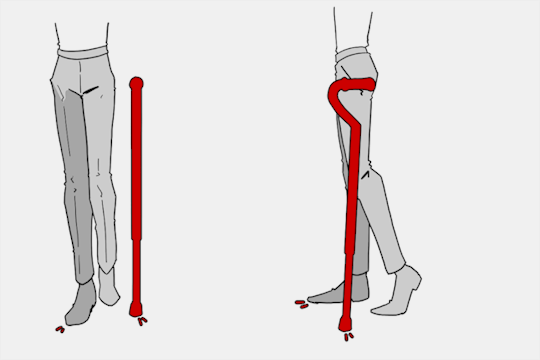
(an animated GIF of a cane matching the natural walking gait. It turns red when pressure is placed on it.)
When going up and down stairs, there is an ideal standard: You want to use the handrail and the cane at the same time, or prioritize the handrail if it's only on one side. When going up stairs you lead with your good leg and follow with the cane and hurt leg together. When going down stairs you lead with the cane and the bad leg and follow with the good leg!
Realistically though, many people don't move out of the way for cane users to access the railing, many stairs don't have railings, and many are wet, rusty, or generally not ideal to grip.
In these cases, if you have a friend nearby, holding on to them is a good idea. Or, take it one step at a time carefully if you're alone.
Now we come to a very common mistake I see... Using fashion canes for medical use!
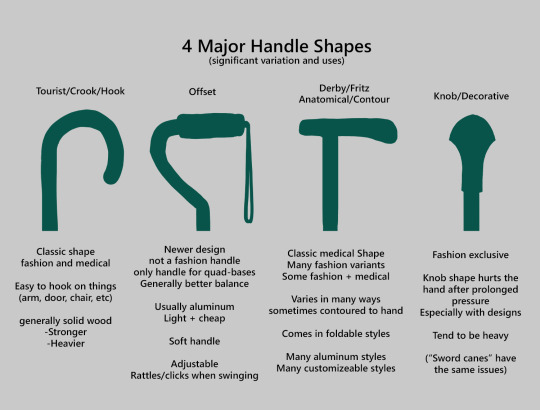
(These are 4 broad shapes, but there is INCREDIBLE variation in cane handles. Research heavily what will be best for your character's specific needs!)
The handle is the contact point for all the weight you're putting on your cane, and that pressure is being put onto your hand, wrist, and shoulder. So the shape is very important for long term use!
Knob handles (and very decorative handles) are not used for medical use for this reason. It adds extra stress to the body and can damage your hand to put constant pressure onto these painful shapes.
The weight of a cane is also incredibly important, as a heavier cane will cause wear on your body much faster. When you're using it all day, it gets heavy fast! If your character struggles with weakness, then they won't want a heavy cane if they can help it!
This is also part of why sword canes aren't usually very viable for medical use (along with them usually being knob handles) is that swords are extra weight!
However, a small knife or perhaps a retractable blade hidden within the base might be viable even for weak characters.
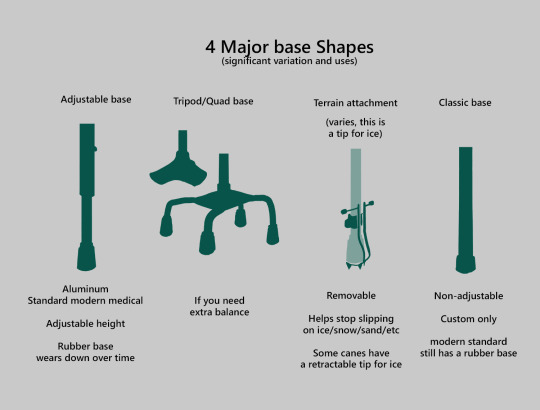
Bases have a lot of variability as well, and the modern standard is generally adjustable bases. Adjustable canes are very handy if your character regularly changes shoe height, for instance (gotta keep the height at your hip!)
Canes help on most terrain with their standard base and structure. But for some terrain, you might want a different base, or to forego the cane entirely! This article covers it pretty well.
Many cane users decorate their canes! Stickers are incredibly common, and painting canes is relatively common as well! You'll also see people replacing the standard wrist strap with a personalized one, or even adding a small charm to the ring the strap connects to. (nothing too large, or it gets annoying as the cane is swinging around everywhere)

(my canes, for reference)
If your character uses a cane full time, then they might also have multiple canes that look different aesthetically to match their outfits!
When it comes to practical things outside of the cane, you reasonably only have one hand available while it's being used. Many people will hook their cane onto their arm or let it dangle on the strap (if they have one) while using their cane arm, but it's often significantly less convenient than 2 hands. But, if you need 2 hands, then it's either setting the cane down or letting it hang!
For this reason, optimizing one handed use is ideal! Keeping bags/items on the side of your free hand helps keep your items accessible.

When sitting, the cane either leans against a wall or table, goes under the chair, or hooks onto the back of the chair. (It often falls when hanging off of a chair, in my experience)
When getting up, the user will either use their cane to help them balance/support as they stand, or get up and then grab their cane. This depends on what it's being used for (balance vs pain when walking, for instance!)
That's everything I can think of for now. Thank you for reading my long-but-absolutely-not-comprehensive list of things to keep in mind when writing or drawing a cane user!
Happy disability pride month! Go forth and make more characters use canes!!!
#mobility aid#cane user#writing tips#writing advice#drawing tips#art tutorial#art tips#art reference#art resources#art help#my art#long post
73K notes
·
View notes
Text
Writing tips for long fics that helped me that no one asked for.
1.) Don't actually delete content from your WIP unless it is minor editing - instead cut it and put it in a secondary document. If you're omitting paragraphs of content, dialog, a whole scene you might find a better place for it later and having it readily available can really save time. Sometimes your idea was fantastic, but it just wasn't in the right spot.
2.) Stuck with wording the action? Just write the dialog then revisit it later.
3.) Stuck on the whole scene? Skip it and write the next one.
4.) Write on literally any other color than a white background. It just works. (I use black)
5.) If you have a beta, while they are beta-ing have them read your fic out loud. Yes, I know a lot of betas/writers do not have the luxury of face-timing or have the opportunity to do this due to time constraints etc but reading your fic out loud can catch some very awkward phrasing that otherwise might be missed. If you don't have a beta, you read it out loud to yourself. Throw some passion into your dialog, you might find a better way to word it if it sounds stuffy or weird.
6.) The moment you have an idea, write it down. If you don't have paper or a pen, EMAIL it to yourself or put it in a draft etc etc. I have sent myself dozens of ideas while laying down before sleep that I 10/10 forgot the next morning but had emailed them to myself and got to implement them.
7.) Remember - hits/likes/kudos/comments are not reflective of the quality of your fic or your ability to write. Most people just don't comment - even if they say they do, they don't, even if they preach all day about commenting, they don't, even if they are a very popular blog that passionately reminds people to comment - they don't comment (I know this personally). Even if your fic brought tears to their eyes and it haunted them for weeks and they printed it out and sent it to their friends they just don't comment. You just have to accept it. That being said - comment on the fic you're reading now, just do it, if you're 'shy' and that's why you don't comment the more you comment the better you'll get at it. Just do it.
8.) Remove unrealistic daily word count goals from your routine. I've seen people stress 1500 - 2000 words a day and if they don't reach that they feel like a failure and they get discouraged. This is ridiculous. Write when you can, but remove absurd goals. My average is 500 words a day in combination with a 40 hour a week job and I have written over 200k words from 2022-2023.
9.) There are dozens of ways to do an outline from precise analytical deconstruction that goes scene by scene to the minimalist bullet point list - it doesn't matter which one you use just have some sort of direction. A partial outline is better than no outline.
10.) Write for yourself, not for others. Write the fic you know no one is going to read. Write the fic that sounds ridiculous. You will be so happy you put it out in the world and there will be people who will be glad it exists.
22K notes
·
View notes
Text
The symbolism of flowers
Flowers have a long history of symbolism that you can incorporate into your writing to give subtext.
Symbolism varies between cultures and customs, and these particular examples come from Victorian Era Britain. You'll find examples of this symbolism in many well-known novels of the era!
Amaryllis: Pride
Black-eyed Susan: Justice
Bluebell: Humility
Calla Lily: Beauty
Pink Camellia: Longing
Carnations: Female love
Yellow Carnation: Rejection
Clematis: Mental beauty
Columbine: Foolishness
Cyclamen: Resignation
Daffodil: Unrivalled love
Daisy: Innocence, loyalty
Forget-me-not: True love
Gardenia: Secret love
Geranium: Folly, stupidity
Gladiolus: Integrity, strength
Hibiscus: Delicate beauty
Honeysuckle: Bonds of love
Blue Hyacinth: Constancy
Hydrangea: Frigid, heartless
Iris: Faith, trust, wisdom
White Jasmine: Amiability
Lavender: Distrust
Lilac: Joy of youth
White Lily: Purity
Orange Lily: Hatred
Tiger Lily: Wealth, pride
Lily-of-the-valley: Sweetness, humility
Lotus: Enlightenment, rebirth
Magnolia: Nobility
Marigold: Grief, jealousy
Morning Glory: Affection
Nasturtium: Patriotism, conquest
Pansy: Thoughtfulness
Peony: Bashfulness, shame
Poppy: Consolation
Red Rose: Love
Yellow Rose: Jealously, infidelity
Snapdragon: Deception, grace
Sunflower: Adoration
Sweet Willian: Gallantry
Red Tulip: Passion
Violet: Watchfulness, modesty
Yarrow: Everlasting love
Zinnia: Absent, affection
#writers#creative writing#writing community#writing#writers of tumblr#writing inspiration#creative writers#writeblr#writerblr#writing tips#flower symbolism#writing subtext#writblr#writers corner#how to write subtext#symbolism in writing#writing advice#creative writing tips#writing resources#writing help#writer tips#writing tips and tricks#helping writers#help for writers#references for writers#writing reference#writers block#beat writers block#novel writing
49K notes
·
View notes
Text
Pirate Terms and Phrases
-> Pirate Lingo
-> A Pirate's Glossary
Batten Down The Hatches - tie everything down and put stuff away for a coming storm.
Brig - a prison on a ship.
Bring a Spring Upon 'er - turn the ship in a different direction
Broadside - the most vulnerable angle of a ship that runs the length of the boat.
Cutlass - a thick, heavy and rather short sword blade.
Dance with Jack Ketch - to hang; death at the hands of the law (Jack Ketch was a famed English executioner).
Davy Jones's Locker - a mythical place at the bottom of the ocean where drowned sailors are said to go.
Dead Men Tell No Tales - the reason given for leaving no survivors.
Flogging - severe beating of a person.
Gangplank - removable ramp between the pier and ship.
Give No Quarter - show no mercy.
Jack - flag flown at the front of the ship to show nationality.
Jolly Roger - black pirate flag with a white skull and crossbones.
Keelhaul - a punishment where someone is dragged under the ship. They are cut by the planks and barnacles on the bottom of the ship.
Landlubber - an inexperienced or clumsy person who doesn't have any sailing skills.
Letters of Marque - government-issued letters allowing privateers the right to piracy of another ship during wartime.
Man-O-War - a pirate ship that is decked out and prepared for battle.
Maroon - to leave someone stranded on a. deserted island with no supplies, typically a punishment for any crew members who disrespected the captain.
Mutiny - a situation in which the crew chooses a new captain, sometimes by forcibly removing the old one.
No Prey, No Pay - a common pirate law that meant crew members were not paid, but rather received a share of whatever loot was taken.
Old Salt - experienced pirate or sailor.
Pillage - to steal/rob a place using violence.
Powder Monkeys - men that performed the most dangerous work on the ship. They were treated harshly, rarely paid, and were expendable.
Privateer - government-appointed pirates.
Run A Shot Across the Bow - fire a warning shot at another boat's Captain.
Scurvy - a disease caused by Vitamin C Deficiency.
Sea Legs - when a sailor adjusts his balance from riding on a boat for a long time.
Strike Colors - lower a ship's flag to indicate surrender.
Weigh Anchor and Hoist the Mizzen - an order to the crew to pull up the anchor and get the ship sailing.
If you like what I do and want to support me, please consider buying me a coffee! I also offer editing services and other writing advice on my Ko-fi! Become a member to receive exclusive content, early access, and prioritized writing prompt requests.
#creative writing#writeblr#pirate writing prompts#pirates#pirate au#glossary#pirate lingo#pirate terms and phrases#pirate language#pirate vocab#pirate vocabulary#victorian slang#how to talk like a pirate#how to write#writing tips#fiction writing#writing advice#writing help#writing resources
12K notes
·
View notes
Text
Artists, let’s talk about Instagram commission scammers
There’s been a huge rise in commission scammers recently, mostly on Instagram. A lot of new artists don’t know what to look out for, so I figured this might help people.
How they begin
Usually the scammer will write to you asking about a commission. Something deceptively cute - mostly I encounter asks about pet portraits, with one or two photos sent. They’ll probably try to sell you a sweet little story, like “It’s for my son’s birthday”. They will insist that they love your artwork and style, even though they don’t follow you or never liked a single piece of your art.
What to look out for:
Their profiles will either be private, empty, or filled with very generic stuff, dating at most a few years back.
Their language will be very simple, rushed or downright bad. They might use weird emojis that nobody ever uses. They will probably send impatient “??” when you don’t answer immediately. They’re in a crunch - lots of people to scam, you know.
They’ll give you absolutely no guidelines. No hints on style, contents aside from (usually) the pet and often a name written on the artwork, no theme. Anything you draw will be perfect. Full artistic freedom. In reality they don’t really care for this part.
They’ll offer you a ridiculous amount of money. Usually 100 or 300 USD (EDIT: I know it might not be a lot for some work. What I mean here - way higher than your asking price, 100 and 300 are standard rates they give). They’ll often put in a phrase like “I am willing to compensate you financially” and “I want the best you can draw”, peppered with vague praise. It will most likely sound way too good to be true. That’s because it is.
Where the scam actually happens
If you agree, they will ask you for a payment method. They’ll try to get to this part as soon as possible.
Usually, they’ll insist on PayPal. And not just any PayPal. They’ll always insist on sending you a transfer immediately. None of that PayPal Invoice stuff (although some do have methods for that, too). They’ll really, REALLY want to get your PayPal email address and name for the transfer - that’s what they’re after. If you insist on any other method, they’ll just circle back to the transfer “for easiest method”. If you do provide them with the info, most likely you’ll soon get a scam email. It most likely be a message with a link that will ultimately lead to bleeding you dry. Never, and I mean NEVER click on any emails or links you get from them. It’s like with any other scam emails you can ever get.
A few things can happen here:
They overpay you and ask for the difference to be wired back. Usually it will go to a different account and you’ll never see that money again.
They’ll overpay you “for shipping costs” and ask you to forward the difference to their shipping company. Just like before, you’ll never see that money again.
The actual owner of the account (yes, they most likely use stolen accounts to wire from) will realize there’s been something sketchy going on and request a refund via official channels. Your account will be charged with fees and/or you get in trouble for fraudulent transactions.
You will transfer the money from your PayPal credit to your bank account and they will make a shitstorm when they want their money back, making your life a living hell. They will call you a scammer, a thief, make wild claims, wearing you down and forcing you into wiring money “back” - aka to their final destination account.
Never, EVER wire money to anyone. This is not how it’s supposed to go. Use PayPal Invoice for secure exchanges where the client needs to provide you with their email, not the other way around.
You can find more info on that method HERE.
What to do when you encounter a scammer:
Ask the right questions: inquire about the style, which artwork of yours they like, as much details as you can. They won’t supply you with any good answers.
Don’t let the rush of the exchange, their praise and the promise of insanely good money to get to you. That’s how they operate, that’s how they make you lose vigilance.
Don’t engage them. As soon as you realize it might be a scam, block them. The sense of urgency they create with their rushed exchange, and pressure they put on you will sooner or later get to you and you might do something that you’ll regret later.
Never wire money to anyone. Never give out your personal data. Never provide your email, name, address or credit card info.
Don’t be deceived by receiving a payment, if you somehow agree to go along with it. Just because it’s there now doesn’t mean it can’t be withdrawn.
Here is a very standard example of such an exchange. I realized it’s a scam pretty fast and went along with it, because I wanted good screenshots for you guys, so I tried going very “by the book” with it.
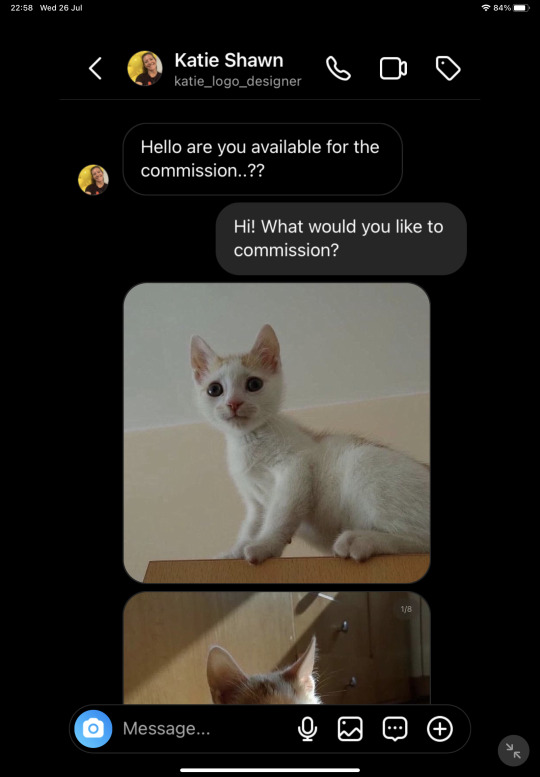





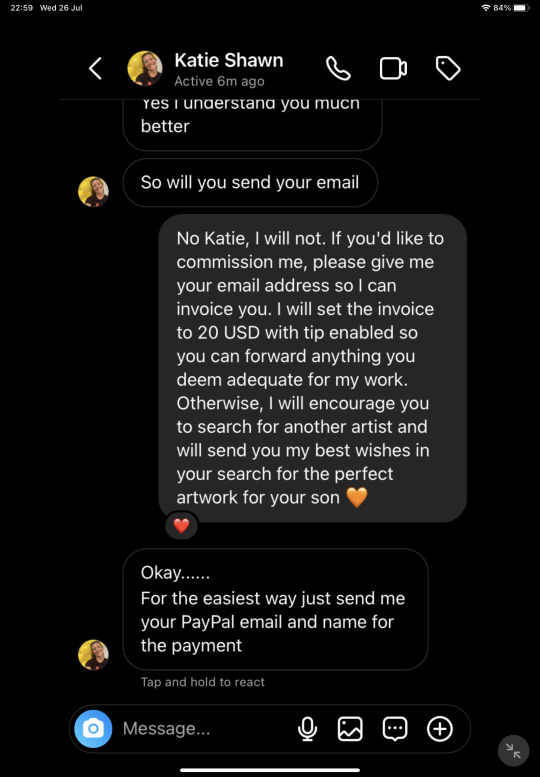
Please share this post, make it reach as many artists as possible. Let young or inexperienced artists know that this is going on. So many people have no idea that this is a thing. Let’s help each other out. If you think I missed any relevant info, do add it as an rb!
Also, if you know other scam methods that you think should be shared, consider rb-ing this post with them below. Having a master post of scam protection would AWESOME to have in the art community.
#art resources#artist help#artist advice#commission advice#scammers#instagram scam#please share with your fellow artists
15K notes
·
View notes
Text
Fantasy Guide to Building A Culture

Culture is defined by a collection of morals, ethics, traditions, customs and behaviours shared by a group of people.
Hierarchy and Social Structures

Within every culture, there is a hierarchy. Hierarchies are an important part of any culture, usually do ingrained that one within the culture wouldn't even question it. Hierarchy can be established either by age, gender or wealth and could even determine roles within their society. Sometimes hierarchy can may be oppressive and rigid whilst other times, ranks can intermingle without trouble. You should consider how these different ranks interact with one another and whether there are any special gestures or acts of deference one must pay to those higher than them. For example, the Khasi people of Meghalaya (Northern India), are strictly matrillineal. Women run the households, inheritance runs through the female line, and the men of the culture typically defer to their mothers and wives. Here are a few questions to consider:
How is a leader determined within the culture as a whole and the family unit?
Is the culture matriarchal? Patriarchal? Or does gender even matter?
How would one recognise the different ranks?
How would one act around somebody higher ranking? How would somebody he expected to act around somebody lower ranking?
Can one move socially? If not, why? If so, how?
Traditions and Customs

Traditions are a staple in any culture. These can be gestures or living life a certain way or to the way a certain person should look. Traditions are a personal detail to culture, they are what make it important. Tradition can dictate how one should keep their home, run their family, take care of their appearance, act in public and even determine relationship. Tradition can also be a double edged sword. Traditions can also be restrictive and allow a culture to push away a former member if they do not adhere to them, eg Traditional expectations of chastity led to thousands of Irish women being imprisoned at the Magdelene Laundries. Customs could be anything from how one treats another, to how they greet someone.
How important is tradition?
What are some rituals your culture undertakes?
What are some traditional values in your world? Does it effect daily life?
Are there any traditions that determine one's status?
Values and Opinions
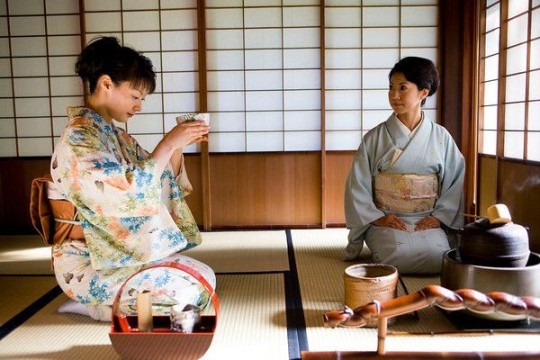
Values and Opinions are the bread and butter of any culture. This is the way your culture sees the world and how they approach different life hurdles. These may differ with other cultures and be considered odd to outsiders, what one culture may value another may not and what opinion another holds, one may not. There will be historical and traditional reasons to why these values and opinions are held. Cultures usually have a paragon to which they hold their members to, a list of characteristics that they expect one to if not adhere to then aspire to. The Yoruba people value honesty, hard work, courage and integrity. Here are some questions to consider?
How important are these ethics and core values? Could somebody be ostracised for not living up to them?
What are some morals that clash with other cultures?
What does your culture precieved to be right? Or wrong?
What are some opinions that are considered to be taboo in your culture? Why?
Dress Code

For many cultures, the way somebody dresses can be important. History and ethics can effect how one is meant to be dressed such as an expectation of chastity, can impose strict modesty. While other cultures, put more importance on details, the different sorts of clothes worn and when or what colour one might wear. The Palestinian people (من النهر إلى البحر ، قد يكونون أحرارا) denoted different family ties, marriage status and wealth by the embroidery and detailing on their thoub.
Are there traditional clothes for your world? Are they something somebody wears on a daily basis or just on occasion?
Are there any rules around what people can wear?
What would be considered formal dress? Casual dress?
What would happen if somebody wore the wrong clothes to an event?
Language

Language can also be ingrained as part of a Culture. It can be a specific way one speaks or a an entirely different language. For example, in the Southern States of America, one can engage in a sort of double talk, saying something that sounds sweet whilst delivering something pointed. Bless their heart. I have a post on creating your own language here.
Arts, Music and Craft

Many cultures are known for different styles of dance, their artwork and crafts. Art is a great part of culture, a way for people to express themselves and their culture in art form. Dance can be an integral part of culture, such as céilí dance in Ireland or the Polka in the Czech Republic. Handicrafts could also be important in culture, such as knitting in Scottish culture and Hebron glass in Palestine. Music is also close to culture, from traditional kinds of singing such as the White Voice in Ukraine and the playing of certain instruments such as the mvet.
Food and Diet
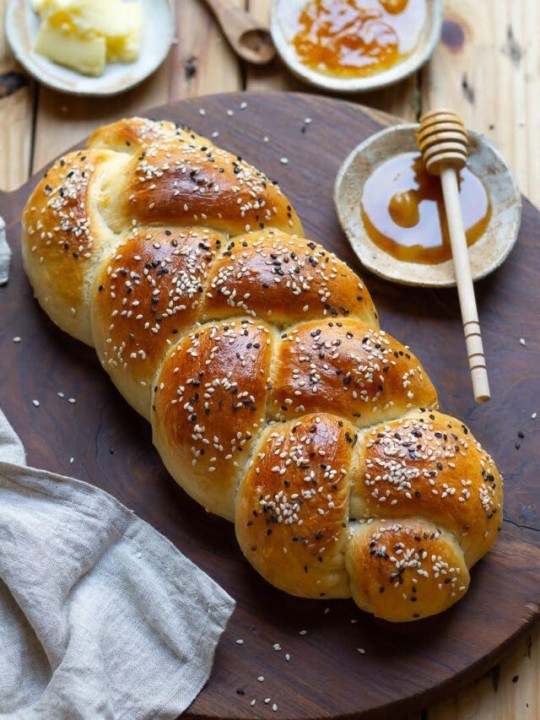
The way a culture prepares or intakes or treats certain foods are important to a culture. In some cultures, there is a diet yo adhere to, certain foods are completely banned. With Jewish culture, pork is prohibited along with fish such as sturgeon, along with shellfish and certain fowl. Meat must also be prepared in a certain way and animal byproducts such as dairy, must never be created or even eaten around this meat. This is known as kosher. The way one consumes food is also important to culture. In some cultures, only certain people may eat together. Some cultures place important on how food is eaten. In Nigerian culture, the oldest guests are served first usually the men before the women. In Japanese culture, one must say 'itadakimasu' (I recieve) before eating. Culture may also include fasting, periods of time one doesn't intake food for a specific reason.
What are some traditional dishes in your world?
What would be a basic diet for the common man?
What's considered a delicacy?
Is there a societal difference in diet? What are the factors that effect diet between classes?
Is there any influence from other cuisines? If not, why not? If so, to what extent?
What would a typical breakfast contain?
What meals are served during the day?
What's considered a comfort food or drink?
Are there any restrictions on who can eat what or when?
Are there any banned foods?
What stance does your world take on alcohol? Is it legal? Can anybody consume it?
Are there any dining customs? Are traditions?
Is there a difference in formal meals or casual meals? If so, what's involved?
Are there any gestures or actions unacceptable at the dinner table?
How are guests treated at meals? If they are given deference, how so?
#Fantasy Guide to Building A Culture#As promised#If I fail my German exam I'm blaming ye#Culture#Building a culture#Fantasy Guide#WorldBuilding#WorldBuilding guide#WorldBuilding help#Writing help#writing#writeblr#writing resources#writing reference#writing advice#ask answered questions#writers#writing advice writing resources#spilled ink#ask answered
9K notes
·
View notes
Text
"But if college was free, then people would abuse that and get useless degrees" hell yeah I would! If I could go to college without debt I would make it my job to get a degree in every little thing that interested me. I'd get a doctorate in film studies. I'd have a bachelor's degree for every science I like. I'd try to learn at least 5 languages with varying results. I would learn something "useful" like coding and then follow it up with a ""useless"" degree like art history. I'd be the world record speed run holder for getting every degree possible.
But I can't afford college without going into massive debt, so instead I spent the last 5 years trying to figure out what I am passionate enough about to consider going into debt over, because unfortunately being passionate about everything is extremely expensive to pursue.
#simon says#i love learning so much and I hate the USA's college debt system#once they make that shit free I will be unstoppable#this topic sprung up because I had the idea that im very academic and annoyingly analytical that I might as well get a degree in it#because without a degree you just seem like an autistic asshole#but with a degree? then you look like a CREDIBLE autistic asshole#don't worry I will still learn but I still want that funky piece of paper to tell everyone I learnt it#also there's some things that are VERY difficult to learn#like I would love to persue this topic further but unfortunately I would need help with that#also before you say 'try taking [blank] classes instead! it's less expensive than a degree!' im broke#my only learning resource is the library sorry about that#also this is not the post to give me unwarranted financial advice#finances are one of the topics I DO NOT care about and I WILL NOT listen to a word you say
17K notes
·
View notes
Text
A good writer, like a good reader, has a mind’s ear. We mostly read prose in silence, but many readers have a keen inner ear that hears it. Dull, choppy, droning, jerky, feeble: these common criticisms of narrative are all faults in the sound of it. Lively, well-paced, flowing, strong, beautiful: these are all qualities of the sound of prose, and we rejoice in them as we read. Narrative writers need to train their mind’s ear to listen to their own prose, to hear as they write.
- Ursula K. Le Guin, Steering the Craft: A 21st Century Guide to Sailing the Sea of Story
#quote#ursula k. le guin#steering the craft#writeblr#writing#writing advice#writing tips#writing resources#writing quotes#dexterreads
9K notes
·
View notes
Note
Can you please share some words to use instead of "Look", I really struggle with that, it's always "She looked at him in shock" or "He looked at her with a smile". I know there's "Gazed" and "Glanced" but I wanted some advice to use "Look" less
Words To Use Instead of "Look"
Words Closest in Meaning (w diff connotations!):
stare
eye
study
behold
glimpse
peek
glance
notice
observe
inspect
regarding
view
review
look-see
get an eyeful
peer
give the eye
eyeball
size up
size up
check out
examine
contemplate
scan
recognize
sweep
once-over
judge
watch
glare
consider
spot
scrunitize
gaze
gander
ogle
yawp
Other (more fancy) words:
glimmer
sntach
zero in
take stock of
poke into
mope
glaze
grope
rummage
frisk
probe
rivet
distinguish
witness
explore
gloat
scowl
have a gander
comb
detect
surveillance
squint
keeping watch
rubberneck
pout
bore
slant
ignore
audit
pipe
search
note
speculation
simper
#writing#writers and poets#creative writing#writers on tumblr#creative writers#helping writers#let's write#poets and writers#writeblr#resources for writers#write every day#write it#write anything#write that down#write#writers#write up#writer community#writerscommunity#female writers#writer things#writblr#writers of tumblr#writers community#writers life#writers block#writing inspiration#writing community#writing advice#writing tips
4K notes
·
View notes
Text
HOW TO GIVE PERSONALITY TO A CHARACTER
Giving personality to a character is an essential part of character development in storytelling, whether you're writing a novel, screenplay, or creating a character for a role-playing game. Here are some steps and considerations to help you give personality to your character:
Understand Their Backstory:
Start by creating a detailed backstory for your character. Where were they born? What were their childhood experiences like? What significant events have shaped their life? Understanding their past can help you determine their motivations, fears, and desires.
2. Define Their Goals and Motivations:
Characters often become more interesting when they have clear goals and motivations. What does your character want? It could be something tangible like a job or a romantic relationship, or it could be an abstract desire like happiness or freedom.
3. Determine Their Strengths and Weaknesses:
No one is perfect, and characters should reflect this. Identify your character's strengths and weaknesses. This can include physical abilities, intellectual skills, and personality traits. Flaws can make characters relatable and three-dimensional.
4. Consider Their Personality Traits:
Think about your character's personality traits. Are they introverted or extroverted? Shy or outgoing? Kind or selfish? Create a list of traits that describe their character. You can use personality frameworks like the Myers-Briggs Type Indicator or the Big Five Personality Traits as a starting point.
5. Give Them Quirks and Habits:
Quirks and habits can make a character memorable. Do they have a specific way of speaking, a unique fashion style, or an unusual hobby? These details can help bring your character to life.
6. Explore Their Relationships:
Characters don't exist in isolation. Consider how your character interacts with others. What are their relationships like with family, friends, and enemies? These relationships can reveal a lot about their personality.
7. Show, Don't Tell:
Instead of explicitly telling the audience about your character's personality, show it through their actions, dialogue, and decisions. Let the reader or viewer infer their traits based on their behavior.
8. Create Internal Conflict:
Characters with internal conflicts are often more engaging. What inner struggles does your character face? These can be related to their goals, values, or past experiences.
9. Use Character Arcs:
Consider how your character will change or grow throughout the story. Character development is often about how a character evolves in response to the events and challenges they face.
10. Seek Inspiration:
Draw inspiration from real people, other fictional characters, or even historical figures. Study how people with similar traits and backgrounds behave to inform your character's actions and reactions.
11. Write Dialogue and Inner Monologues:
Writing dialogue and inner monologues from your character's perspective can help you get inside their head and understand their thought processes and emotions.
12. Consider the Setting:
The setting of your story can influence your character's personality. For example, a character who grows up in a war-torn environment may have a different personality than one raised in a peaceful, affluent society.
13. Revise and Refine:
Don't be afraid to revise and refine your character as you write and develop your story. Characters can evolve and change as the narrative unfolds.
Remember that well-developed characters are dynamic and multi-faceted. They should feel like real people with strengths, weaknesses, and complexities. As you write and develop your character, put yourself in their shoes and think about how they would react to various situations. This will help you create a compelling and believable personality for your character.
#writeblr#writing advice#creative writing#writerscommunity#writer problems#writing resources#writing community#writers on tumblr#writers block#the writer struggle#writing tips#writers#uservolkova
11K notes
·
View notes
Text
Hey content consumers!!
Did you know you can search for multiple tags on tumblr???
When you perform a search you can enter more than one tag with a comma in between to narrow down your results!
That means that you can totally search for the #sicktember 2023 tag along with your favorite fandom/alternative fandom tag! With any luck, something super awesome will pop up!
On a similar note- content creators are encouraged to use the #sicktember 2023 tag so others can find and enjoy your work!
Also, be sure to check out the 2023 collection on AO3!
And don't forget to like, reblog, comment, and kudos!!

#sicktember#sicktember 2023#resources and advice#ao3 collection#tags#how to tag#sick character#sickfic#sickfic prompts#whump event#fanfiction#fan art#all media event#all fandom event#whump#whump hurt/comfort#whump tropes#writing prompts#prompt event#30 days of prompts#sick characters
77 notes
·
View notes
Text
10 Tips for Crafting Authentic Characters
Give them depth: Create characters with multidimensional personalities, including strengths, weaknesses, quirks, and flaws. They should have a mix of virtues and vices that make them relatable and interesting.
Provide backstory: Develop a detailed backstory for each character, even if only a fraction of it makes it into your story. Understanding a character's past experiences, traumas, and motivations will inform their actions and decisions in the present.
Show their emotions: Allow your characters to express a range of emotions realistically. Show how they react to different situations, both internally and externally, to make them feel human and relatable.
Give them distinct voices: Each character should have a unique way of speaking, with distinct vocabulary, syntax, and speech patterns. This helps readers differentiate between characters and adds authenticity to their dialogue.
Create internal conflicts: Give your characters inner struggles and conflicting desires that they must grapple with throughout the story. Internal conflicts add depth and complexity to characters, making them more believable.
Show their relationships: Develop meaningful relationships between characters, whether they're familial, romantic, platonic, or adversarial. Show how these relationships evolve and influence the characters' development over time.
Make them evolve: Characters should grow and change over the course of the story, driven by their experiences and the challenges they face. Allow them to learn from their mistakes, overcome obstacles, and develop as individuals.
Ground them in reality: Anchor your characters in the real world by giving them relatable experiences, hobbies, jobs, or cultural backgrounds. Incorporating realistic details adds depth and authenticity to their portrayal.
Show their flaws: Imperfect characters are often the most compelling. Don't be afraid to showcase your characters' flaws and vulnerabilities; these imperfections make them more relatable and human.
Give them agency: Allow your characters to drive the plot forward through their actions, decisions, and choices. Avoid making them passive observers or mere vehicles for the story's events. Characters with agency feel more authentic and engaging to readers.
#writing tips#writing advice#writers on tumblr#writeblr#creative writing#fiction writing#writerscommunity#writing#writing help#writing resources
4K notes
·
View notes
Text
Let's talk about fight scenes.
Writing fight scenes requires a delicate balance of action, emotion, and detail to keep readers engaged and immersed in the moment.
Here are some tips to craft compelling fight scenes:
Know your characters: Understand their fighting styles, strengths, and weaknesses—are they offensive, or defensive? Spontaneous, or strategic? Trigger-happy, or reluctant? Their personalities and motivations will influence their actions and decisions during the fight.
Create tension: Build tension leading up to the fight to increase the stakes and make the action more gripping. Foreshadowing, verbal sparring, or physical intimidation can all contribute to a sense of anticipation.
Use sensory details: Engage the reader's senses by describing the sights, sounds, smells, and physical sensations of the fight. This helps to create a vivid and immersive experience—but make sure not to overdo it. Too much detail can distract from the adrenaline of the fight.
Maintain clarity: Ensure that the action is easy to follow by using clear and concise language. Avoid overly complicated sentences or excessive description that could confuse readers.
Focus on emotions: Show the emotional impact of the fight on your characters. Describe their fear, anger, determination, or adrenaline rush to make the scene more compelling and relatable.
Include strategic elements: Incorporate tactics, strategy, and improvisation into the fight to make it more dynamic and realistic. Think about how your characters use their surroundings, weapons, or special abilities to gain an advantage.
Balance dialogue and action: Intersperse dialogue with action to break up the fight scene and provide insight into the characters' thoughts and intentions. Dialogue can also reveal or support the characters' personalities and motivations.
Keep it concise: While it's important to provide enough detail to immerse readers in the action, avoid unnecessary padding or overly long fight scenes. Keep the pacing brisk to maintain momentum and keep readers hooked.
Show the consequences: Illustrate the aftermath of the fight, including injuries, emotional trauma, or changes in relationships between characters. This adds depth to the scene and helps to drive the story forward.
Hope this helped ❤
#writeblr#writing#writing tips#writing advice#writing help#writing resources#creative writing#fight scenes#deception-united
4K notes
·
View notes
Text
show, don't tell:
anticipation
- bouncing legs
- darting eyes
- breathing deeply
- useless / mindless tasks
- eyes on the clock
- checking and re-checking
frustration
- grumbling
- heavy footsteps
- hot flush
- narrowed eyes
- pointing fingers
- pacing / stomping
sadness
- eyes filling up with tears
- blinking quickly
- hiccuped breaths
- face turned away
- red / burning cheeks
- short sentences with gulps
happiness
- smiling / cheeks hurting
- animated
- chest hurts from laughing
- rapid movements
- eye contact
- quick speaking
boredom
- complaining
- sighing
- grumbling
- pacing
- leg bouncing
- picking at nails
fear
- quick heartbeat
- shaking / clammy hands
- pinching self
- tuck away
- closing eyes
- clenched hands
disappointment
- no eye contact
- hard swallow
- clenched hands
- tears, occasionally
- mhm-hmm
tiredness
- spacing out
- eyes closing
- nodding head absently
- long sighs
- no eye contact
- grim smile
confidence
- prolonged eye contact
- appreciates instead of apologizing
- active listening
- shoulders back
- micro reactions
#lyralit#writing tips#writerblr#creative writing#writblr#writers#writing#writers block#writing ideas#writing prompts#writing help#writing advice#writing resources#writing characters#emotions#show don't tell#describing#writing prompt
91K notes
·
View notes
Text
free resources to write a novel in 2024
hello hello! it's me, rach!
as the new year approaches, many of us set goals and resolutions - myself included. one of my goals for 2024 is to write a novel (I've been procrastinating on this for quite a long time now). i assume that some of you might have the same goal, that's why I'm writing this post today.
over 2023 i've been releasing some freebies for authors just like me, so I thought I could compile my favorites in this post. hope you find this useful :)
1) the writer's workbook
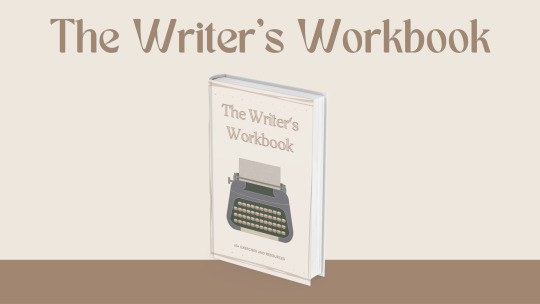
this workbook has over 60 exercises to help you develop characters, scenarios, etc. if you're ever stuck, I'm pretty sure this workbook will be your best friend.
2) author's corner (notion template)

this is the most downloaded freebie in my shop! it is a notion dashboard with everything you need to organize your writing and has some templates included (like scrivener)!!
3) another notion template
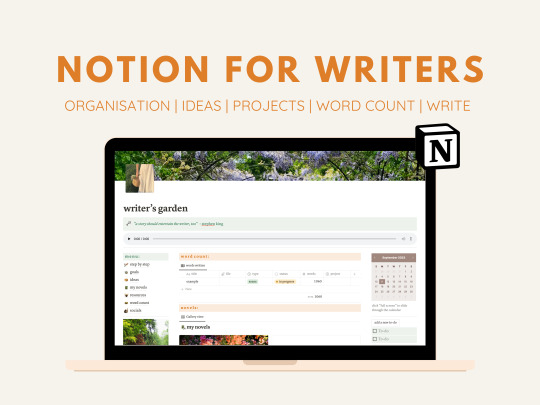
this one has two themes you can choose from: cottage-core and dark academia. they're very similar to the previous template, but this one is more recent and I added some new features. feel free to explore both and pick the one you like the most.
4) the author's journal

this is a cute printable with 20 pages that will help you stay on track and manage your social media accounts as a writer who shares their work online. you can also register what you're currently writing and your personal research and resources.
5) plan your book printable
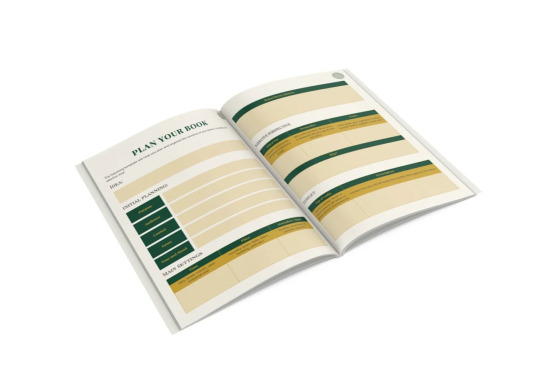
this is a 6-page printable for you to fill out and plan your book easily and effectively.
6) excel sheet to organize tasks & word-count

this is a simple excel sheet, but it is very effective for keeping track of your tasks & word-count of your novels. also, it is 100% customizable to your liking!
that's all for now! feel free to explore my gumroad shop where I have plenty of freebies to grab! also, don't forget to subscribe so that you never miss any opportunity to get a goodie for free :)
hope this post was useful!
have a nice day,
rach
#writing resources#writing#writeblr#writer tips#writing advice#writing help#writing tips#poetsandwriters#resources#research#wattpad#nanowrimo#creative writing#writerscommunity#writers#writing inspiration#writing prompts#writing reference#writerslife#writersofinstagram#software#inspiration#writing inspo#for writing#for writers#for whoever needs it#writing research#researching#we love an useful post#useful
3K notes
·
View notes